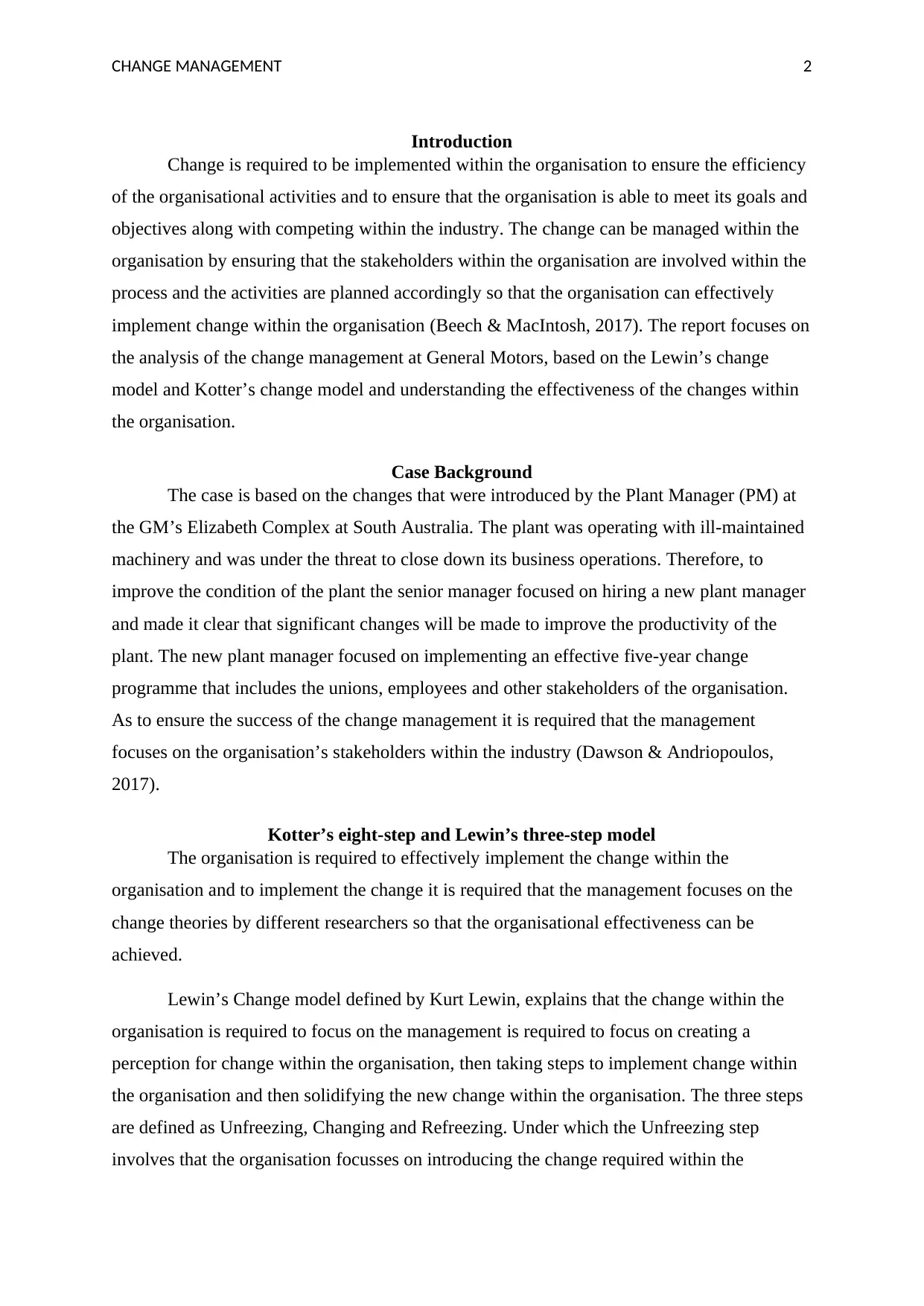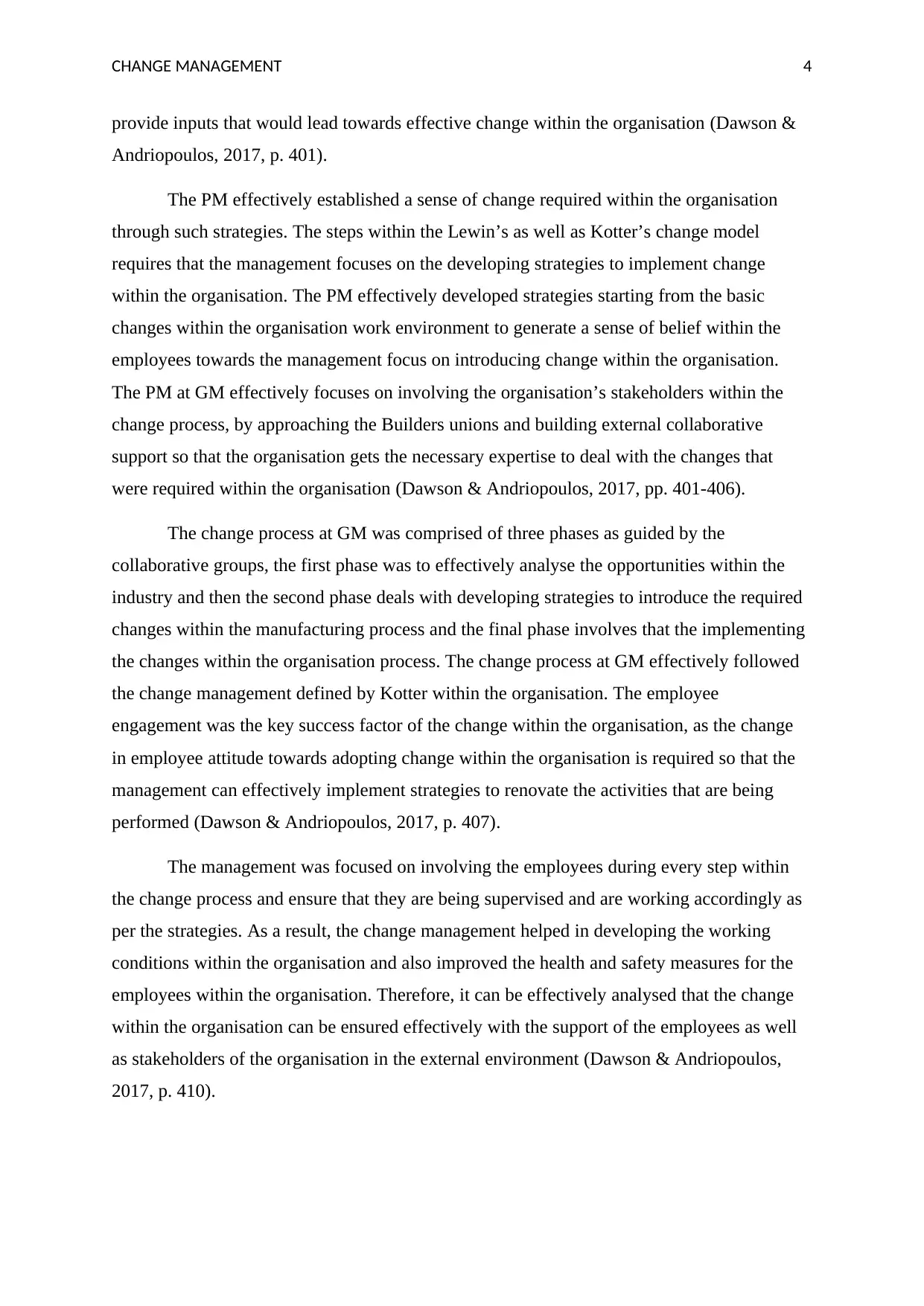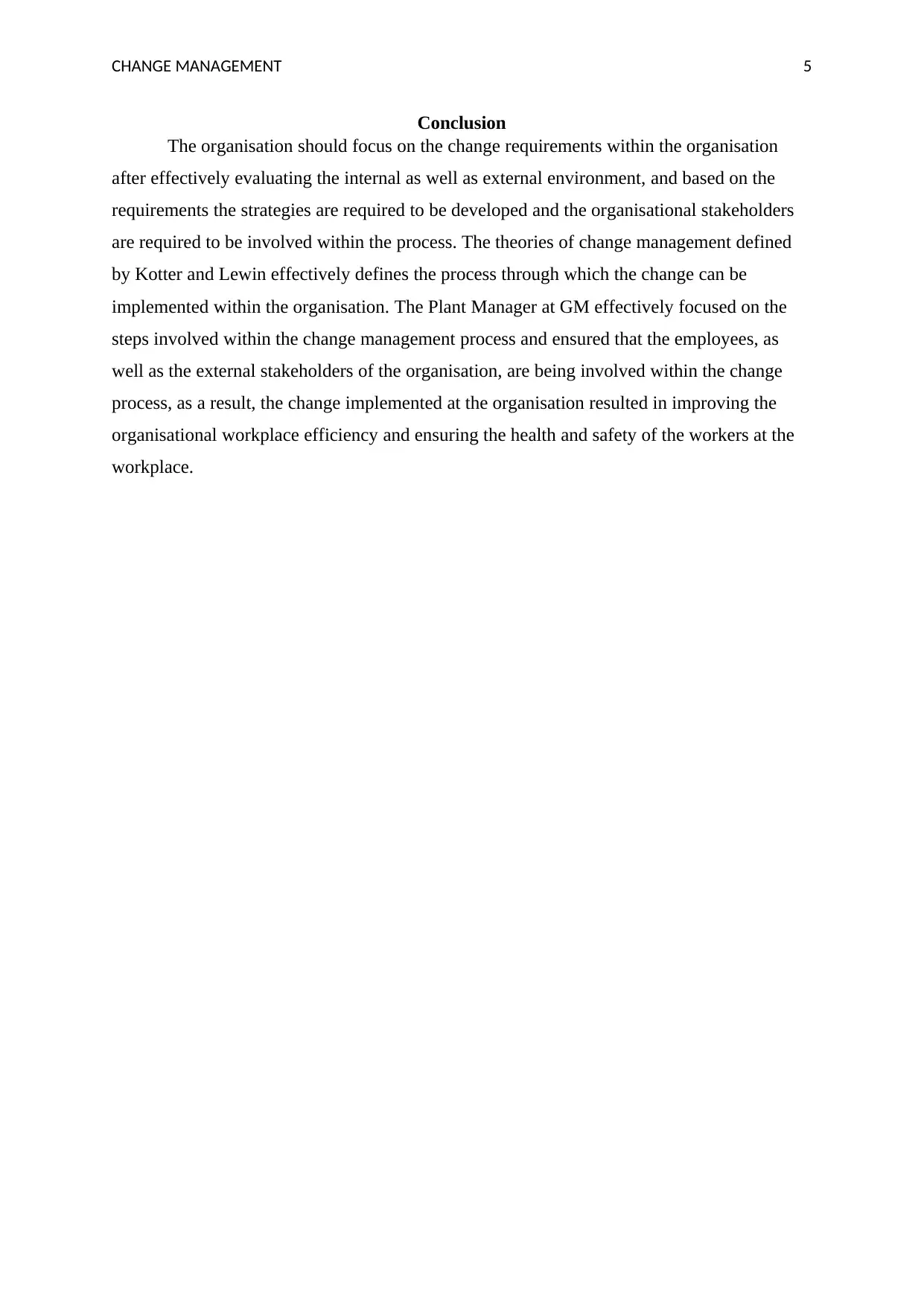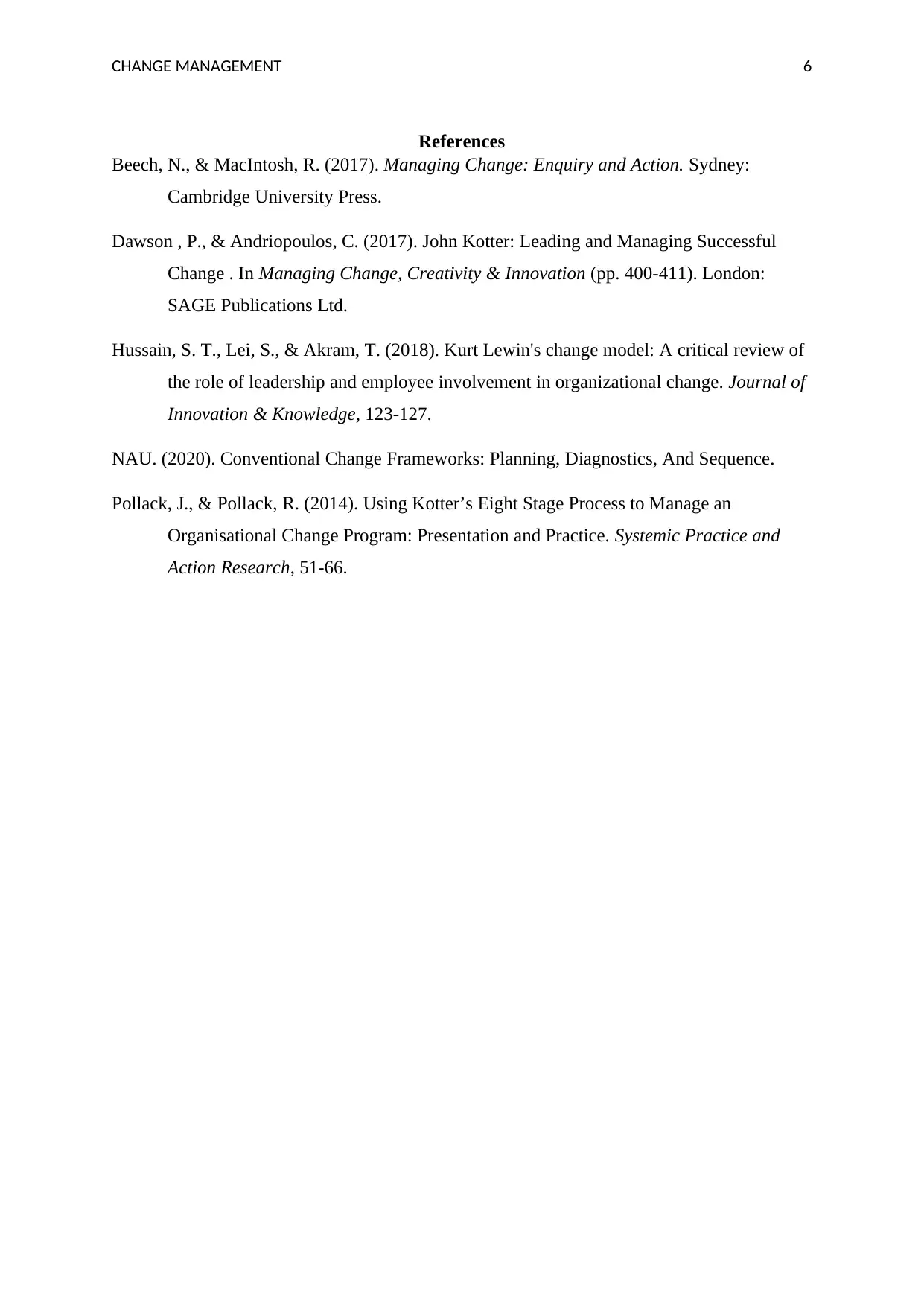Change Management Case Study: General Motors - Analysis & Strategies
VerifiedAdded on 2022/08/12
|7
|1610
|18
Case Study
AI Summary
This case study examines the change management initiatives at General Motors (GM), particularly focusing on the Elizabeth Complex in South Australia. The analysis centers on the application of Kotter's eight-step model and Lewin's three-step model (Unfreezing, Changing, Refreezing) to understand the effectiveness of the changes. The study highlights the critical role of employee involvement, as demonstrated by the plant manager's open-door policy and stakeholder engagement, in driving successful organizational change. The changes at GM involved a five-year program addressing ill-maintained machinery and the threat of plant closure. The case illustrates how the plant manager's strategies, including employee engagement and external collaboration, fostered improved working conditions, enhanced safety measures, and overall organizational efficiency. The conclusion emphasizes the importance of aligning change strategies with both internal and external stakeholders and the effectiveness of Kotter's and Lewin's models in guiding the change process. The case highlights the successful implementation of change, leading to improved workplace efficiency and safety, which can be applied to other organizations.

2020
CHANGE MANAGEMENT
Case study of General motors
SystemJP
CHANGE MANAGEMENT
Case study of General motors
SystemJP
Paraphrase This Document
Need a fresh take? Get an instant paraphrase of this document with our AI Paraphraser

CHANGE MANAGEMENT 1
Table of Contents
Introduction................................................................................................................................2
Case Background.......................................................................................................................2
Kotter’s eight-step and Lewin’s three-step model.....................................................................2
Changes at GM...........................................................................................................................3
Conclusion..................................................................................................................................4
References..................................................................................................................................6
Table of Contents
Introduction................................................................................................................................2
Case Background.......................................................................................................................2
Kotter’s eight-step and Lewin’s three-step model.....................................................................2
Changes at GM...........................................................................................................................3
Conclusion..................................................................................................................................4
References..................................................................................................................................6

CHANGE MANAGEMENT 2
Introduction
Change is required to be implemented within the organisation to ensure the efficiency
of the organisational activities and to ensure that the organisation is able to meet its goals and
objectives along with competing within the industry. The change can be managed within the
organisation by ensuring that the stakeholders within the organisation are involved within the
process and the activities are planned accordingly so that the organisation can effectively
implement change within the organisation (Beech & MacIntosh, 2017). The report focuses on
the analysis of the change management at General Motors, based on the Lewin’s change
model and Kotter’s change model and understanding the effectiveness of the changes within
the organisation.
Case Background
The case is based on the changes that were introduced by the Plant Manager (PM) at
the GM’s Elizabeth Complex at South Australia. The plant was operating with ill-maintained
machinery and was under the threat to close down its business operations. Therefore, to
improve the condition of the plant the senior manager focused on hiring a new plant manager
and made it clear that significant changes will be made to improve the productivity of the
plant. The new plant manager focused on implementing an effective five-year change
programme that includes the unions, employees and other stakeholders of the organisation.
As to ensure the success of the change management it is required that the management
focuses on the organisation’s stakeholders within the industry (Dawson & Andriopoulos,
2017).
Kotter’s eight-step and Lewin’s three-step model
The organisation is required to effectively implement the change within the
organisation and to implement the change it is required that the management focuses on the
change theories by different researchers so that the organisational effectiveness can be
achieved.
Lewin’s Change model defined by Kurt Lewin, explains that the change within the
organisation is required to focus on the management is required to focus on creating a
perception for change within the organisation, then taking steps to implement change within
the organisation and then solidifying the new change within the organisation. The three steps
are defined as Unfreezing, Changing and Refreezing. Under which the Unfreezing step
involves that the organisation focusses on introducing the change required within the
Introduction
Change is required to be implemented within the organisation to ensure the efficiency
of the organisational activities and to ensure that the organisation is able to meet its goals and
objectives along with competing within the industry. The change can be managed within the
organisation by ensuring that the stakeholders within the organisation are involved within the
process and the activities are planned accordingly so that the organisation can effectively
implement change within the organisation (Beech & MacIntosh, 2017). The report focuses on
the analysis of the change management at General Motors, based on the Lewin’s change
model and Kotter’s change model and understanding the effectiveness of the changes within
the organisation.
Case Background
The case is based on the changes that were introduced by the Plant Manager (PM) at
the GM’s Elizabeth Complex at South Australia. The plant was operating with ill-maintained
machinery and was under the threat to close down its business operations. Therefore, to
improve the condition of the plant the senior manager focused on hiring a new plant manager
and made it clear that significant changes will be made to improve the productivity of the
plant. The new plant manager focused on implementing an effective five-year change
programme that includes the unions, employees and other stakeholders of the organisation.
As to ensure the success of the change management it is required that the management
focuses on the organisation’s stakeholders within the industry (Dawson & Andriopoulos,
2017).
Kotter’s eight-step and Lewin’s three-step model
The organisation is required to effectively implement the change within the
organisation and to implement the change it is required that the management focuses on the
change theories by different researchers so that the organisational effectiveness can be
achieved.
Lewin’s Change model defined by Kurt Lewin, explains that the change within the
organisation is required to focus on the management is required to focus on creating a
perception for change within the organisation, then taking steps to implement change within
the organisation and then solidifying the new change within the organisation. The three steps
are defined as Unfreezing, Changing and Refreezing. Under which the Unfreezing step
involves that the organisation focusses on introducing the change required within the
⊘ This is a preview!⊘
Do you want full access?
Subscribe today to unlock all pages.

Trusted by 1+ million students worldwide

CHANGE MANAGEMENT 3
organisation to the employees and develop a perception within the organisation that supports
change within the organisation. The next step involves Changing the organisational activities
and implementing change within the organisation. The last step within the change process is
the Refreezing, which defines that the changes made within the organisation is required to be
ensured within the organisation and should be focused that the activities are being performed
accordingly (Hussain, Lei, & Akram, 2018).
Kotter’s eight-step change model is an expanded form of the change model defined by
Kurt Lewin. The change model by Kotter defines that an effective change process comprises
of eight steps starting from establishing a sense of urgency which means that the management
needs to identify the need of change within the organisation after analysing the industry
factors, the next step is to develop a team that would be focused towards working together to
introduce change within the organisation. The next step is to introduce an effective vision that
would motivate the team or the group to develop strategies that would lead towards the
change within the organisation (Pollack & Pollack, 2014).
The next step defined by Kotter after developing the strategies is to communicate the
change strategies and vision to the employees within the organisation. As the strategies have
been effectively communicated within the organisation the management is required to focus
on the obstacles or the barriers that may influence the change implementation within the
organisation. The next step in the process is to developing short-term plans and recognising
the employees that are involved in the process. The next step within the process is to ensure
that the activities are being performed as per planned and the process ends with ensuring that
the change has been effectively implemented and the goals and objectives of the organisation
are being achieved (NAU, 2020).
Changes at GM
The Lewin’s change model defines the change model in three simple steps, but the
change management defined by Kotter effectively defines the steps that are involved within
the change management process and the organisation can effectively lead towards
implementing change within the organisation. The changes implemented at GM were
effective as they focused on ensuring that the employees within the organisation are involved
within the change process and the activities are being conducted by them effectively to
implement the change within the organisation. The PM at GM effectively focused on the
employee involvement and introduced an open-door policy to encourage the employee to
organisation to the employees and develop a perception within the organisation that supports
change within the organisation. The next step involves Changing the organisational activities
and implementing change within the organisation. The last step within the change process is
the Refreezing, which defines that the changes made within the organisation is required to be
ensured within the organisation and should be focused that the activities are being performed
accordingly (Hussain, Lei, & Akram, 2018).
Kotter’s eight-step change model is an expanded form of the change model defined by
Kurt Lewin. The change model by Kotter defines that an effective change process comprises
of eight steps starting from establishing a sense of urgency which means that the management
needs to identify the need of change within the organisation after analysing the industry
factors, the next step is to develop a team that would be focused towards working together to
introduce change within the organisation. The next step is to introduce an effective vision that
would motivate the team or the group to develop strategies that would lead towards the
change within the organisation (Pollack & Pollack, 2014).
The next step defined by Kotter after developing the strategies is to communicate the
change strategies and vision to the employees within the organisation. As the strategies have
been effectively communicated within the organisation the management is required to focus
on the obstacles or the barriers that may influence the change implementation within the
organisation. The next step in the process is to developing short-term plans and recognising
the employees that are involved in the process. The next step within the process is to ensure
that the activities are being performed as per planned and the process ends with ensuring that
the change has been effectively implemented and the goals and objectives of the organisation
are being achieved (NAU, 2020).
Changes at GM
The Lewin’s change model defines the change model in three simple steps, but the
change management defined by Kotter effectively defines the steps that are involved within
the change management process and the organisation can effectively lead towards
implementing change within the organisation. The changes implemented at GM were
effective as they focused on ensuring that the employees within the organisation are involved
within the change process and the activities are being conducted by them effectively to
implement the change within the organisation. The PM at GM effectively focused on the
employee involvement and introduced an open-door policy to encourage the employee to
Paraphrase This Document
Need a fresh take? Get an instant paraphrase of this document with our AI Paraphraser

CHANGE MANAGEMENT 4
provide inputs that would lead towards effective change within the organisation (Dawson &
Andriopoulos, 2017, p. 401).
The PM effectively established a sense of change required within the organisation
through such strategies. The steps within the Lewin’s as well as Kotter’s change model
requires that the management focuses on the developing strategies to implement change
within the organisation. The PM effectively developed strategies starting from the basic
changes within the organisation work environment to generate a sense of belief within the
employees towards the management focus on introducing change within the organisation.
The PM at GM effectively focuses on involving the organisation’s stakeholders within the
change process, by approaching the Builders unions and building external collaborative
support so that the organisation gets the necessary expertise to deal with the changes that
were required within the organisation (Dawson & Andriopoulos, 2017, pp. 401-406).
The change process at GM was comprised of three phases as guided by the
collaborative groups, the first phase was to effectively analyse the opportunities within the
industry and then the second phase deals with developing strategies to introduce the required
changes within the manufacturing process and the final phase involves that the implementing
the changes within the organisation process. The change process at GM effectively followed
the change management defined by Kotter within the organisation. The employee
engagement was the key success factor of the change within the organisation, as the change
in employee attitude towards adopting change within the organisation is required so that the
management can effectively implement strategies to renovate the activities that are being
performed (Dawson & Andriopoulos, 2017, p. 407).
The management was focused on involving the employees during every step within
the change process and ensure that they are being supervised and are working accordingly as
per the strategies. As a result, the change management helped in developing the working
conditions within the organisation and also improved the health and safety measures for the
employees within the organisation. Therefore, it can be effectively analysed that the change
within the organisation can be ensured effectively with the support of the employees as well
as stakeholders of the organisation in the external environment (Dawson & Andriopoulos,
2017, p. 410).
provide inputs that would lead towards effective change within the organisation (Dawson &
Andriopoulos, 2017, p. 401).
The PM effectively established a sense of change required within the organisation
through such strategies. The steps within the Lewin’s as well as Kotter’s change model
requires that the management focuses on the developing strategies to implement change
within the organisation. The PM effectively developed strategies starting from the basic
changes within the organisation work environment to generate a sense of belief within the
employees towards the management focus on introducing change within the organisation.
The PM at GM effectively focuses on involving the organisation’s stakeholders within the
change process, by approaching the Builders unions and building external collaborative
support so that the organisation gets the necessary expertise to deal with the changes that
were required within the organisation (Dawson & Andriopoulos, 2017, pp. 401-406).
The change process at GM was comprised of three phases as guided by the
collaborative groups, the first phase was to effectively analyse the opportunities within the
industry and then the second phase deals with developing strategies to introduce the required
changes within the manufacturing process and the final phase involves that the implementing
the changes within the organisation process. The change process at GM effectively followed
the change management defined by Kotter within the organisation. The employee
engagement was the key success factor of the change within the organisation, as the change
in employee attitude towards adopting change within the organisation is required so that the
management can effectively implement strategies to renovate the activities that are being
performed (Dawson & Andriopoulos, 2017, p. 407).
The management was focused on involving the employees during every step within
the change process and ensure that they are being supervised and are working accordingly as
per the strategies. As a result, the change management helped in developing the working
conditions within the organisation and also improved the health and safety measures for the
employees within the organisation. Therefore, it can be effectively analysed that the change
within the organisation can be ensured effectively with the support of the employees as well
as stakeholders of the organisation in the external environment (Dawson & Andriopoulos,
2017, p. 410).

CHANGE MANAGEMENT 5
Conclusion
The organisation should focus on the change requirements within the organisation
after effectively evaluating the internal as well as external environment, and based on the
requirements the strategies are required to be developed and the organisational stakeholders
are required to be involved within the process. The theories of change management defined
by Kotter and Lewin effectively defines the process through which the change can be
implemented within the organisation. The Plant Manager at GM effectively focused on the
steps involved within the change management process and ensured that the employees, as
well as the external stakeholders of the organisation, are being involved within the change
process, as a result, the change implemented at the organisation resulted in improving the
organisational workplace efficiency and ensuring the health and safety of the workers at the
workplace.
Conclusion
The organisation should focus on the change requirements within the organisation
after effectively evaluating the internal as well as external environment, and based on the
requirements the strategies are required to be developed and the organisational stakeholders
are required to be involved within the process. The theories of change management defined
by Kotter and Lewin effectively defines the process through which the change can be
implemented within the organisation. The Plant Manager at GM effectively focused on the
steps involved within the change management process and ensured that the employees, as
well as the external stakeholders of the organisation, are being involved within the change
process, as a result, the change implemented at the organisation resulted in improving the
organisational workplace efficiency and ensuring the health and safety of the workers at the
workplace.
⊘ This is a preview!⊘
Do you want full access?
Subscribe today to unlock all pages.

Trusted by 1+ million students worldwide

CHANGE MANAGEMENT 6
References
Beech, N., & MacIntosh, R. (2017). Managing Change: Enquiry and Action. Sydney:
Cambridge University Press.
Dawson , P., & Andriopoulos, C. (2017). John Kotter: Leading and Managing Successful
Change . In Managing Change, Creativity & Innovation (pp. 400-411). London:
SAGE Publications Ltd.
Hussain, S. T., Lei, S., & Akram, T. (2018). Kurt Lewin's change model: A critical review of
the role of leadership and employee involvement in organizational change. Journal of
Innovation & Knowledge, 123-127.
NAU. (2020). Conventional Change Frameworks: Planning, Diagnostics, And Sequence.
Pollack, J., & Pollack, R. (2014). Using Kotter’s Eight Stage Process to Manage an
Organisational Change Program: Presentation and Practice. Systemic Practice and
Action Research, 51-66.
References
Beech, N., & MacIntosh, R. (2017). Managing Change: Enquiry and Action. Sydney:
Cambridge University Press.
Dawson , P., & Andriopoulos, C. (2017). John Kotter: Leading and Managing Successful
Change . In Managing Change, Creativity & Innovation (pp. 400-411). London:
SAGE Publications Ltd.
Hussain, S. T., Lei, S., & Akram, T. (2018). Kurt Lewin's change model: A critical review of
the role of leadership and employee involvement in organizational change. Journal of
Innovation & Knowledge, 123-127.
NAU. (2020). Conventional Change Frameworks: Planning, Diagnostics, And Sequence.
Pollack, J., & Pollack, R. (2014). Using Kotter’s Eight Stage Process to Manage an
Organisational Change Program: Presentation and Practice. Systemic Practice and
Action Research, 51-66.
1 out of 7
Related Documents
Your All-in-One AI-Powered Toolkit for Academic Success.
+13062052269
info@desklib.com
Available 24*7 on WhatsApp / Email
![[object Object]](/_next/static/media/star-bottom.7253800d.svg)
Unlock your academic potential
Copyright © 2020–2025 A2Z Services. All Rights Reserved. Developed and managed by ZUCOL.




